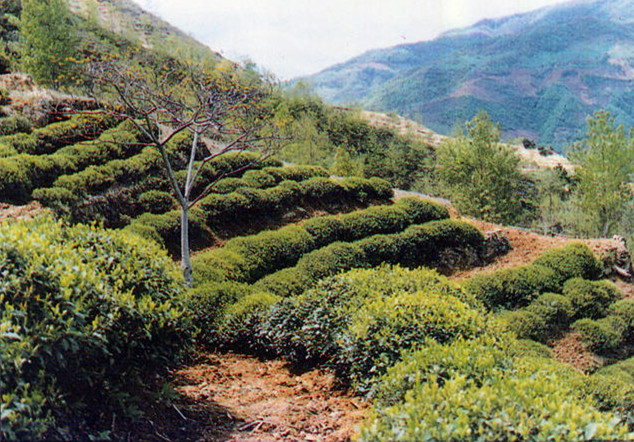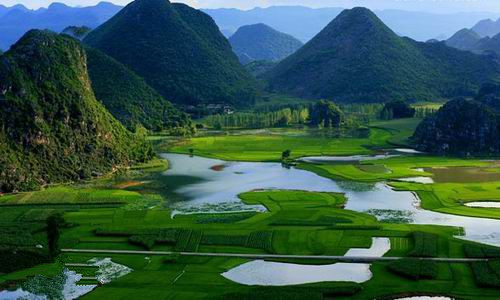
Wenshan National Nature Reserve
Chinese Name: 文山国家级自然保护区
English Name: Wenshan National Nature Reserve
Overview
Wenshan National Nature Reserve is located in Wenshan Zhuang and Miao Autonomous Prefecture, Yunnan Province, within the southeastern part of Yunnan. It lies near the Tropic of Cancer. The reserve covers a total area of 344,406 hectares, including a core area of 10,304.62 hectares, a buffer zone of 7,793.48 hectares, and an experimental area of 8,768.90 hectares. It is classified as a forest ecosystem reserve aimed at preserving various species of Magnoliaceae plants, such as Michelia macclurei, and their ecological environments, including monsoon evergreen broadleaf forests and montane moss evergreen broadleaf forests.
Historical Development
- 1958: Establishment of two state-owned forest farms in Laojunshan, Wenshan County, and Pingzhai, Xichou County, approved by Yunnan Provincial Forestry Department.
- 1980: The Wenshan Revolutionary Committee approved the merger to create a provincial-level nature reserve.
- 1986: Establishment of Xiaoqiaogou Provincial Nature Reserve.
- 1997: Establishment of Laojunshan Provincial Nature Reserve.
- 2000: Expansion and merger to form the “Yunnan Wenshan Nature Reserve.”
- 2003: Merger of the Xiaoqiaogou and Laojunshan reserves, upgraded to a national nature reserve with State Council approval. Administrative jurisdiction belongs to Xichou County and Wenshan County.
- 2023: Listed as an important habitat for terrestrial wild animals in the first batch of the “Important Terrestrial Wildlife Habitat Directory” published by the National Forestry and Grassland Administration.
Geographical Environment
- Location: The reserve is situated in the southeastern Yunnan, straddling Wenshan and Xichou Counties, near the Tropic of Cancer. Geographic coordinates are 103°53′E to 104°10′E, 104°41′E to 104°52′E, and 23°16′N to 23°25′N, 23°21′N to 23°24′N.
- Soil: The main soil types are yellow soil and yellow-brown soil, with a pH of 6 to 6.5, and a thickness ranging from 60 to 120 cm. The majority of slopes are north-facing (shady slopes) with gradients between 15 to 25 degrees.
- Terrain: The Laojunshan area is situated on the southwestern side of Liuzhao Mountain, characterized by medium-mountain landforms. The area has experienced extensive geological activity, including sedimentation and tectonic movements. The highest peak is Buzhu Mountain, at 2,991.2 meters, while the lowest point is the Nan’guo River in Yaodian, at 1,500 meters, with a relative elevation difference of about 1,500 meters.
- Topography: The reserve features a range of landforms, including medium-mountain terrain, karst erosion hills, faulted karst basins, and various karst micro-landforms. Most of the area is medium-mountain terrain, with karst erosion hills in the east, south, and around Xiaoqiaogou. The canyon topography is mainly around the granite massifs of Buzhu Mountain, with wide karst valleys in the eastern region and near Xiaoqiaogou.
Climate Characteristics
- General Climate: Located on a low-latitude plateau in southeastern Yunnan, the reserve experiences a South Asian subtropical monsoon climate with varying climatic conditions based on elevation, including Central Asian subtropical, Northern subtropical, South Asian subtropical, and temperate climates.
- Laojunshan Area: Situated south of the Tropic of Cancer, it has a subtropical monsoon climate with distinct vertical climatic features due to geographical position, terrain, and altitude. The annual average temperature is 14.5°C. There is a significant temperature difference between the upper and lower parts of the mountain, and rainfall varies accordingly. The average annual precipitation is about 1,022.2 mm, with 1,000 to 1,400 mm in the lower parts and over 1,400 mm in the upper parts. The upper mountain receives more rainfall and mist, with high humidity supporting dense forest growth.
- Xiaoqiaogou Area: Exhibits a South Asian subtropical monsoon climate, influenced by the southeast Pacific monsoon. Annual rainfall averages 1,200 mm, with 80% falling between May and October, and a dry season from March to May. Frost-free periods are long, with frequent dense fog from December to February, maintaining high relative humidity above 80%, which supports the growth of evergreen broadleaf forests.
Area and Boundaries
Wenshan National Nature Reserve is located in Wenshan Zhuang and Miao Autonomous Prefecture, Yunnan Province, with geographic coordinates 103°53′E to 104°10′E, 104°41′E to 104°52′E, and 23°16′N to 23°25′N, 23°21′N to 23°24′N. The total area is 344,406 hectares, with a core area of 10,304.62 hectares, a buffer zone of 7,793.48 hectares, and an experimental area of 8,768.90 hectares.
Conservation Targets
Wenshan National Nature Reserve is a forest ecosystem reserve focused on protecting species of Magnoliaceae plants, such as Michelia macclurei, and their habitats, including monsoon evergreen broadleaf forests and montane moss evergreen broadleaf forests.
- Plants: The reserve is home to 187 families, 946 genera, and 3,085 species of wild seed plants, with tropical components being dominant. There are also 45 families, 100 genera, and 262 species of ferns. The reserve features 139 large fungi species, 7 unknown species, and 30 micro-fungi species.
- Animals: The reserve’s diverse animal species include 31 orders, 103 families, and 459 species of wild vertebrates, such as 86 species of mammals, 221 species of birds, 92 species of amphibians and reptiles, and 60 species of fish. Notably, the bird species diversity is particularly rich compared to nearby nature reserves.
Ecological and Scientific Value
The complex and stable geological conditions of Wenshan National Nature Reserve make it a critical refuge for many plant species and a significant part of the ancient and unique centers of Yunnan, Guizhou, and Guangxi. It houses numerous ancient species, such as Michelia macclurei, and is a crucial area for plant evolution, with a high density of vascular plants. The reserve is also a center for Magnoliaceae plants, requiring high forest habitat quality and humidity. It contains numerous type specimens of new plant species, adding to its scientific importance.



 7 Days GolfingTour
7 Days GolfingTour
 8 Days Group Tour
8 Days Group Tour
 8 Days Yunnan Tour
8 Days Yunnan Tour
 7 Days Shangri La Hiking
7 Days Shangri La Hiking
 11 Days Yunnan Tour
11 Days Yunnan Tour
 6 Days Yuanyang Terraces
6 Days Yuanyang Terraces
 11 Days Yunnan Tour
11 Days Yunnan Tour
 8 Days South Yunnan
8 Days South Yunnan
 7 Days Tea Tour
7 Days Tea Tour
 8 Days Muslim Tour
8 Days Muslim Tour
 12 Days Self-Driving
12 Days Self-Driving
 4 Days Haba Climbing
4 Days Haba Climbing
 Tiger Leaping Gorge
Tiger Leaping Gorge
 Stone Forest
Stone Forest
 Yunnan-Tibet
Yunnan-Tibet
 Hani Rice Terraces
Hani Rice Terraces
 Kunming
Kunming
 Lijiang
Lijiang
 Shangri-la
Shangri-la
 Dali
Dali
 XishuangBanna
XishuangBanna
 Honghe
Honghe
 Kunming
Kunming
 Lijiang
Lijiang
 Shangri-la
Shangri-la
 Yuanyang Rice Terraces
Yuanyang Rice Terraces
 Nujiang
Nujiang
 XishuangBanna
XishuangBanna
 Spring City Golf
Spring City Golf
 Snow Mountain Golf
Snow Mountain Golf
 Stone Mountain Golf
Stone Mountain Golf















